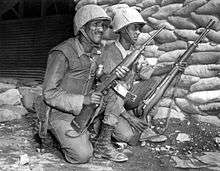Kebur Zabagna
Kebur Zabagna or Zebenya (Amharic: ክቡር ዘበኛ, romanized: kəbur zãbãňňya, lit. 'honorable guard') was the Ethiopian Imperial Guard. Also known as the First Division, this unit served the dual purposes of providing security for the Emperor of Ethiopia, and being an elite infantry division. It was not, however, part of the organizational structure of the Ethiopian regular army as it was part of the Zebagna, the Addis Ababa Guard. The Kebur Zabagna was based at Addis Ababa.
| Kebur Zabagna | |
|---|---|
 Ethiopian Soldiers, part of the Kagnew Battalion, 7th Inf. Div., Korea, 1953 | |
| Active | 1917–1936 1941–1974 |
| Country | |
| Branch | Ethiopian Imperial Guard |
| Type | Infantry |
| Size | 9 Battalions |
| Garrison/HQ | Addis Ababa |
| Patron | Emperor of Ethiopia |
| Engagements | Second Italo-Abyssinian War |
| Commanders | |
| Ceremonial chief | Emperor of Ethiopia |
Overview
Richard Pankhurst dates the formation of the Imperial Bodyguard (previously known as the Mehal Sefari) to 1917, when the Regent Ras Tafari (later the Emperor Haile Selassie) assembled a unit under his direct control from men who had trained in the British army in Kenya as well as a few who had served under the Italians in Tripoli.[1] In 1930 as Negus he invited a Belgian military mission to train and modernize the Ethiopian military, which included the Kebur Zabagna. The unit was organized in three battalions of trained regular infantry armed with rifles, machineguns and mortars; one battalion consisted of men from the earlier mahal safari. The Kebur Zabagna also had one heavy machine-gun company. It was commanded by Ethiopian graduates of Saint Cyr, the French military academy, at the time of the Italian invasion of Ethiopia.[2] As a unit, the Imperial Bodyguard only participated in the Battle of Maychew (31 March 1936), where they inflicted heavy losses on the 2nd Eritrean Division until the Ethiopian troops were forced to withdraw; the Imperial Guard thereafter served in the rearguard. Afterwards many of its members joined the various groups of the Ethiopian resistance.
Following the return of Emperor Haile Selassie to Ethiopia, the Kebur Zabagna was reconstituted, and a Swedish military mission aided in its training. Men for the Kagnew Battalion, which fought in the Korean War, were drawn from the Imperial Bodyguard.[3]
"It remained the elite force of the empire," notes historian Bahru Zewde, "until discredited in the wake of the attempted coup of 1960." That unsuccessful coup had been planned by its commander Brigadier-General Mengistu Neway, and his brother Germame Neway.[4] In 1961 it numbered nine battalions; in 1969 some 7,000 men. In 1974 the Commander was Major-General Tafessa Lemma. The Kebur Zabagna was disbanded after the Derg consolidated their hold on Ethiopia.
The first permanent military band in the country to be established the Imperial Bodyguard Ban in 1929 under the direction of Swiss conductor Andre Nicod. Notable members of the Imperial Bodyguard Band included Tilahun Gessesse[5] and Mahmoud Ahmed.[6] It was notable for its implementation of western style military music conventions in a first for any African nation.[7]
Notes
- Pankhurst, Richard (1968). Economic History of Ethiopia, 1800-1935. Addis Ababa: Haile Sellassie I University Press. p. 562.
- Bahru Zewde, A History of Modern Ethiopia, second edition (Oxford: James Currey, 2001), p. 148
- Bahru Zewde, A History, p. 186, and Fantahun Ayele, "The Ethiopian Army: from Victory to Collapse 1977-91, Evanston, Northwestern University Press, 2014, 12.
- Paul B. Henze, Layers of Time (New York: Palgrave, 2000), pp. 254f.
- "Tilahun Gessesse laid to rest". Ethiopian News Agency. 23 April 2009. Archived from the original on 25 April 2009. Retrieved 23 April 2009.
- Falceto, Francis (1999). Almaz 1973 (Media notes). Éthiopiques. Mahmoud Ahmed. Buda Musique. 829792.
- Kidane, Birhane (1993). The Origin and Development of the Imperial Guard Band (1924-1974). B.A. Thesis, Department of History, Addis Ababa University.